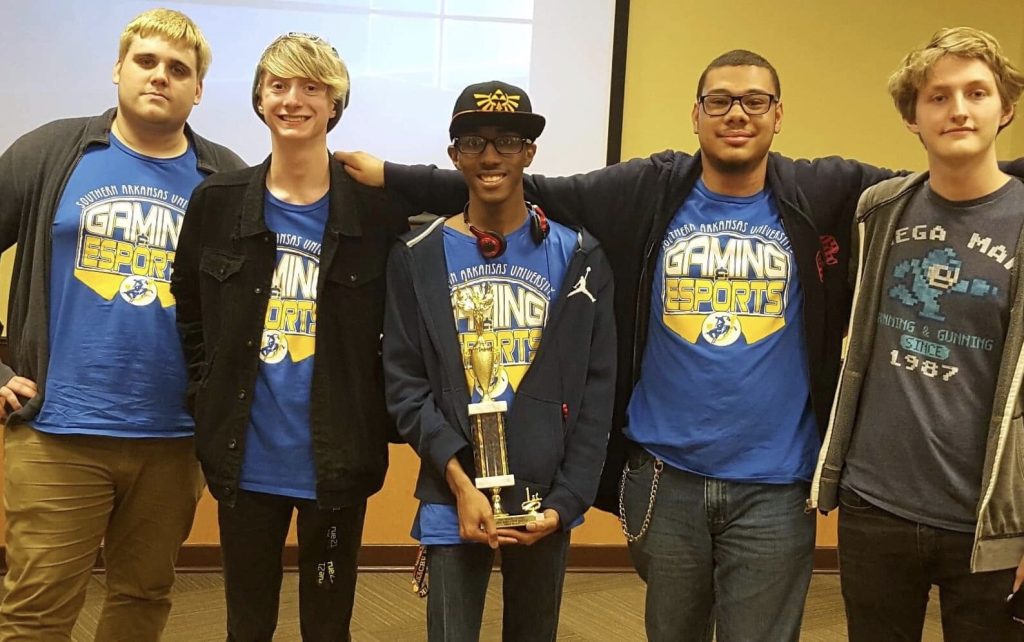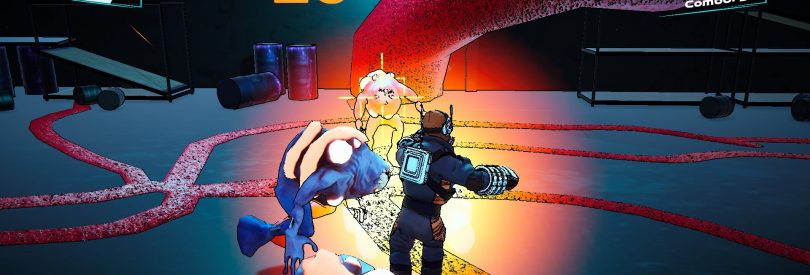About Esports at SAU
Southern Arkansas University offers two levels of esports athletic membership: varsity and non-varsity teams.
Varsity: Mulerider Esports varsity teams compete against other collegiate teams across the United States and Canada in dedicated collegiate leagues. Varsity players represent SAU at the highest gaming level and team positions are competitive. Scholarships are available for varsity team members.
Non-Varsity: Mulerider Esports non-varsity teams compete in a variety of local and online competitions. These titles are not offered in competitive collegiate leagues, but SAU is dedicated to providing competitive opportunities for these titles.
Mulerider Esports encourages ranked play to discover and analyze player skill levels. Players who do not play ranked are invited to attend open team tryouts at the beginning of each semester.
Games
Varsity Teams:
- Apex Legends
- League of Legends
- Call of Duty: Modern Warfare III
- EA Sports FC 24
- Fortnite
- Madden 24
- NBA 2K24
- Overwatch 2
- Rainbow 6 Siege
- Rocket League
- Street Fighter 6
- Super Smash Bros Ultimate
- Valorant
Non-Varsity Teams:
- Guilty Gear: Strive
- Mortal Kombat 1
- Dragon Ball Fighterz
Leagues
Mulerider Esports is involved in a variety of national and regional competition leagues.

- NACE (National Association of Collegiate Esports)
- Arkansas Central Smash
- Arkansas Fighting Game Network
- College CoD (CCL)
- Collegiate Starleague
- East Coast Athletic Conference (ECAC)
- Local and regional open tournaments
Mulerider Esports opened their first gaming arena Fall 2023. This area is designated only for Mulerider Esports athletes and touts five competition computer labs, two console rooms, and a streaming lab. The arena is open for team competition and practices throughout the year.
The Gaming Hub is located on the 2nd floor of the Reynolds Center. This area offers 18 gaming computer stations, as well as areas for table top gaming and hanging out. This gaming area is open to all SAU students.
An additional gaming computer lab is located in Honors Hall to allow esports athletes to practice where they live.
Southern Arkansas University currently offers a variety of Esports scholarships for recruitment and performance. For more information, please contact Sandra Martin.

SAU’s affordable tuition and the Computer Game and Animation Design programs create an attractive option for anyone interested in computer game development. The curriculum provides innovative ways for students to become active in the community and a healthy outlet for eSports participants.
Contact
 Sandra Martin
Sandra Martin
Mulerider Esports Director
sesmith@saumag.edu
Nelson Hall 115
(870)235-4047
Discord: Secmartins1#9239
Learn more about the Game and Animation Design programs at SAU.

University Requirement (2 hours)
GSTD 1002 – Freshman Seminar
General Education (32 hours)
Note: 3 hours of fine arts/humanities requirements are included in the major. ART 2013 – Art Appreciation cannot fulfill the fine arts/humanities requirements.
Game and Animation Design (87 hours)
ART 1013 – Drawing I
ART 1023 – Three-Dimensional Design
ART 1033 – Concept Art or ART 1113 – Drawing II
ART 1043 – Two-Dimensional Design
ART 1103 – Introduction to Game Development
ART 2093 – Introduction to Playgramming
ART 2123 – Graphic Software Applications
ART 2133 – Basic Digital Photography
ART 2143 – Art History I
ART 2183 – Game Design Management
ART 2193 – Introduction to 3D Modeling Tools
ART 3053 – Animation I
ART 3093 – Physics of Animation
ART 3123 – Art History II
ART 3133 – 3D Character Design and Sculpture
ART 3143 – 3D Character Rigging
ART 3153 – Simulation Development I
ART 3223 – Illustration or ART 3543 – Figure Drawing
ART 4132 – Senior Capstone Review
ART 4153 – Animation II
ART 4173 – Simulation Development II
ART 4193 – Game Development Senior Project
CSCI 2103 – Computer Science I and CSCI 2101 – Computer Science I Lab
CSCI 2133 – Game Development
CSCI 3043 – Game Studio Workshop or CSCI 3913 – Virtual Reality Workshop
Select 3 hours from the following:
ART 4033 – History of Modern Art
ART 4063 – Art History Seminar I
ART 4073 – Art History Seminar II
Select 3 hours from the following:
ART 4013 – Special Topics in Art I
ART 4023 – Advanced Art Studio I
ART 4113 – Special Topics in Art II
ART 4123 – Advanced Art Studio II
ART 4163 – Advanced Level Visual Design
Select 6 hours from the following:
ART 3353 – Multimedia and Web Design I
ART 3363 – Advanced Digital Photography
ART 4353 – Multimedia and Web Design II
CSCI 2113 – Computer Science II and CSCI 2111 – Computer Science II Lab
DC 2333 – Fundamentals of Digital Cinema
DC 3333 – Intermediate Digital Cinema
ENGL 4043 – World Creation and Design
A minor area is not required but is recommended.
Minor Requirements:
Game Design Minor (21 hours)
ART 1103 – Introduction to Game Development
ART 2183 – Game Design Management
ENGL 3003 – Advanced Professional Writing
CSCI 2133 – Game Development or ART 2093 – Introduction to Playgramming
CSCI 3043 – Game Studio Workshop or CSCI 3913 – Virtual Reality Workshop
Specialty Area (6 hours)
Select one of the following options:
Designer/Producer
SPCH 1113 – Introduction to Public Speaking
MGMT 3023 – Organizational Theory and Behavior
Designer/Writer
ENGL 4043 – World Creation and Design
THEA 3403 – Playwriting I
Game Systems Designer
GBUS 2013 – Statistics and Analytics I
ECON 2103 – Principles of Microeconomics or MATH 3043 – Applied Probability and Statistics I
- 2025-2026
- 2024-2025
- 2023-2024 [pdf]
- 2022-2023 [pdf]
- 2021-2022 [pdf]
- 2020-2021 [pdf]
- 2019-2020 [pdf]
- 2018-2019 [pdf]
- 2016-2017 [pdf]
- 2015-2016 [pdf]
- 2014-2015 [pdf]
- 2013-2014 [pdf]
| Department: | |
| Hours Required: | 121 |
| Categories: | Major, Undergraduate |
| Delivery: | On-Campus |
Have you ever dreamed of designing your own 3D games or a 3D prototype of a new product? Game animation and simulation is the perfect major for you! Students in-game animation and simulation design are taught 3D animation techniques as well as the production and management of game environments. They are also trained for a broad variety of scenarios that require prototyping 3D designs for manufacturers of medical equipment, transportation, and the military.
Courses in this program prepare students for professional practice in game, animation, and simulation design by applying technical, and theoretical skills to solve problems using open-source and other software applications. Upon completion of the program, students will be able to critically analyze, develop, and produce engaging mass media projects associated with a variety of entertainment, industrial, commercial, and educational fields.
Learning Goals
- Students will be able to communicate orally, visually and in written form to support a visual art or design decision.
- Students will understand art in terms of its civic and ethical impact.
- Students critically analyze visual design problems, synthesize information and create pieces with corresponding written or oral language to support their outcomes.
- Students employ traditional art techniques and technological knowledge necessary to work in the art and design community.
- Students use the tools and technology related to their specific concentration, and will acquire an informed voice as it pertains to art history.
software, engineering, computer, interface, game, gaming, design, animation, 3D, modeling, drawing, writing

